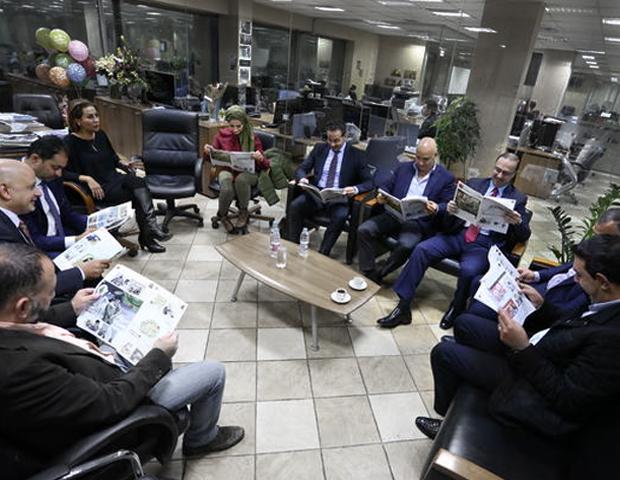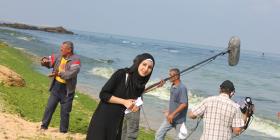TOMATO CARTOON: ARAB CARTOONISTS UNITE IN A MONTHLY MAGAZINE

- The Jordanian Prime Minister Hani al-Mulki stands before a graph symbolising inflation
- Donald Trump wakes up next to a frightened Statue of Liberty
- A terrorist passes through a security gate with sticks of dynamite in place of a brain
These images are all related to the news of the past few months and made the front page of the magazine ‘Tomato Cartoon’. This twenty-page monthly magazine, distributed since last December with the Jordanian daily Al Ghad, is the first magazine which is entirely dedicated to pan-Arab cartoons.
At the head of the magazine is Naser Jafari, a Jordanian cartoonist with nearly thirty years’ experience. He has collaborated with numerous Lebanese, Palestinian and Jordanian newspapers and has received several international awards: “It was an old dream,” he says. “All that comes out of our part of the world are successive crises and terrorism. We wanted to send out a different, civilised message against terrorism. In my mind, this message had to come from cartoonists of all countries.”
A wish which can be seen in the title and logo of the newspaper “Tomato Cartoon”: “The tomato is part of our culinary culture. It’s a staple food, accessible to all, even to the poorest people. And as it is present all over the Mediterranean, it was a way of implying that we are connected to our neighbours, like France or Spain. We eat tomatoes, like everyone else.”
IN SEARCH OF REGIONAL COHESION
“Like everyone else,” repeats Naser Jafari like a mantra, highlighting the pan-Arab cohesion that emerges from his magazine. “I want people to know that we share the same problems as all the Arab countries: corruption, terrorism, governments… We also share the same dreams.” The magazine wants to bear witness to current times, explains Joumana Ghnaymat, a Jordanian journalist, in the introduction of the first issue of Tomato Cartoon: “Tomato Cartoon’s ambition is to be a historic landmark for the sensitive political period that the world is currently going through.”
Ambition achieved at first glance, if we list the subjects covered in the first issue: from Fayrouz’s 81st birthday to the Arab world’s bad habit of firing gunshots for all sorts of events, passing by Daech, corruption, Palestinian prisoners, Syrian refugees, the waste crisis in Lebanon and the emigration of young Moroccans… The drawings were made by nineteen cartoonists from eight Arab countries, America and Turkey.
Naser Jafari is in contact with artists via social networks, which he believes facilitate regional cohesion. This was how, for instance, he suggested to Naji Benaji that he participate regularly to Tomato Cartoon. The Moroccan cartoonist is part of a network of cartoonists on the internet. He states: “Before, we didn’t necessarily know what the others were drawing. Now, on the internet, we can keep track of what everyone else is doing.” An opinion to which Yves Gonzales-Quijano, a teacher in Arabic literature and a researcher at the University of Lyon II, adds: “The drawings have always circulated widely, from one country to another; there have been exhibitions, competitions and many opportunities to meet one another. The biggest countries for cartoons, like Egypt, Lebanon, Syria and Iraq, have always exchanged drawings. But there is now a new cartoonist school in the Gulf, quite modern and interesting.” The only ones excluded from this regional momentum, according to the researcher, are the countries of the Maghreb. “There has always been a gap between the Maghreb and the rest of the Arab world, on the one hand because of the language and on the other hand because the Maghreb press has never managed to establish a newspaper that found an audience further to the East in the Arab world.”
Naji Benaji made the decision not to comment on his drawings when they were intended for an audience outside of his own country. Many of the cartoons of Tomato Cartoon are not accompanied by any comments or dialogue, in order to “reach the widest possible audience”, according to Nasser Jafari. The question of language was often debated in Arabic press and cartoons since their joint development at the end of the 19th Century. Yves Gonzales-Quijano returns to this question: “We have opted for classical Arabic, or the Arabic of the press in newspapers, in place of dialects. But in cartoons, when there is dialogue, it’s almost always in dialect. It’s a sign that cartoons maintain a link with their audience which is not necessarily scholarly and elitist in nature.”
Not commenting on cartoons in order to find an audience outside of those speaking the local dialect is a strategy for those artists who would like to see a regional unity emerge in their field. “This magazine will give us a new lease of life, and help to unite Arab cartoonists after the Arab Spring that divided us. Before, all the Arab caricaturists were united around a single cause, the Palestinian cause,” explains Naji Benaji. Since the Arab Revolutions in the spring of 2011, and in particular since the Syrian conflict, the opinions of Arab intellectuals differ greatly: “Everyone is tearing each other apart over the Arab Spring, and especially over the Syrian issue. Cartoons reflect this,” explains Yves Gonzales-Quijano. According to him, the Palestinian cause is not the only one in the spotlight today: “Every country has its problems: no government in Morocco since the last elections, tensions on the southern border of Algeria, inflation in Egypt and Jordan, war in Syria, Iraq and Yemen… In this context, the Palestinian issue is no longer at the forefront.” Not to mention the financial weight of Saudi Arabia, “which controls much of the media and is attempting a rapprochement with Israel. Palestinian press cartoons are therefore less present in corporate media.”
A CERTAIN FREEDOM OF DRAWING
Naser Jafari has chosen to circumvent sensitive issues: no political mention of the Syrian conflict, for example, in Tomato Cartoon. “We don’t want to take sides. We prefer, for example, to allude to the conflict via the refugee crisis. But we’re still targeting Daech.”
Another sensitive subject that isn’t addressed in Tomato Cartoon – and rarely in Arabic cartoons in general – is that of religion. “We would like to speak freely, but without hurting anyone,” explains the editor. Naser Jafari explains candidly that Tomato Cartoon was created in resistance to the humour of Charlie Hebdo. For him, as for Naji Benaji, to caricature the prophet Mohammed is to go too far and this has “struck people in their faith and in their beliefs”. Other subjects are, in fact, avoided in the cartoons of the Arab world. “The forbidden triangle”, explains Yves Gonzales-Quijano, “is religion, sex and politics. But the freedom of institutional press is considerably reduced: if we compare what is done today with old Egyptian press drawings in the 1960s or 70s, they were much more caustic.” At that time, one could find cartoons making fun of sheikhs. “But gently, without insulting them,” he clarifies, “a bit like the way Don Camillo was made fun of.”
So in order to avoid insult, or by cultural choice, certain subjects are avoided. Can we call this self-censorship? Naser Jafari and his team choose, however, to tackle the subject of politics with pencil strokes, like with the front page of the Jordanian Prime Minister and the graph of inflation. Even if they have not received any negative feedback on this front cover, it doesn’t mean that this freedom was easily gained. “Jordan was one of the safest countries to launch this project,” explains Naser Jafari. “We have unions, laws which defend the press. Journalists aren’t harshly punished by the government.” But even in this rather favourable situation, the team still had to wait for almost a year to obtain the authorisation to publish the magazine. A long administrative process which the editor-in-chief still cannot explain. “The project being the first of its kind, had to be presented to the media commission of Jordan for examination. After a first approval, the project was put aside again, due to a change of government.”
Fortunately, the desire to carry out the project overcame all these obstacles and the collaboration with the newspaper Al Ghad proved to be solid. The Jordanian daily provides technical and logistical assistance for the printing of the magazine and its distribution. The support of the collaborators has also been infallible up to now since they provide the drawings for free. “We are looking for funds, but we don’t want an organisation or government to control the contents of our publications,” says Naser Jafari.
The economic model of this first pan-Arab periodical dedicated to cartoons is therefore still fragile, but this does not discourage Naser Jafari. Even if he doesn’t make it a priority, he would like to develop partnerships with other newspapers from Arab countries in the future in order to distribute his monthly magazine more widely.
Content produced in partnership with Cineuropa







